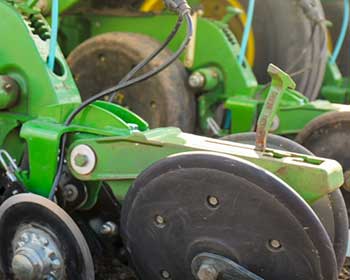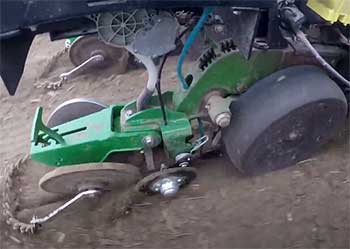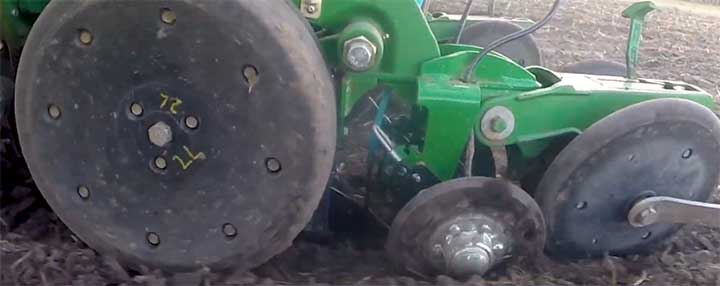The Yield 360 BANDIT is an innovative liquid fertilizer application system designed by AgXtend to provide efficient in-furrow deposition of nutrients on planters. By applying fertilizer directly into the seed trench, the BANDIT aims to promote early nutrient availability and healthier root development.
However, as with any new technology, there have been some notable issues reported with the Yield 360 BANDIT since its release. In this article, we’ll provide an overview of the most common problems growers have encountered with their Yield 360 BANDIT units and offer potential solutions.
Problems With Yield 360 BANDIT
- Clogged Hoses
One of the most frequently reported problems with the BANDIT system is clogged hoses, particularly the main application hoses that run from the tanks to the row units.

Thick fertilizer products like 10-34-0 or ammonium thiosulfate are prone to settling out and crystallizing inside the hoses, especially if the system sits idle for extended periods.
This can lead to flow interruptions or complete blockages.
To help avoid clogged hoses, it’s recommended to flush the entire BANDIT circuit with water after each use.
This helps rinse any residual fertilizer from the system. Growers should also avoid letting fertilizer mixtures sit for long durations without agitation.
Installing a recirculation kit can help keep products suspended when not planting. Switching to thinner, lower-salt formulations may also reduce crystallization issues in the hoses.
If clogs do occur, replace hoses with severe blockages. For minor buildups, run a declogging solution like Sentinel through the system. Increasing hose diameter can also help reduce clogs with viscous fertilizers.
- Leaking Fittings
Another common frustration is leaking fittings, typically at the row unit inlets or at connection points between hose segments. This often results from vibrating parts loosening over time.
Leaks not only create messy residue on planter components but also lead to inaccurate application rates.
To reduce leaking issues, thoroughly inspect and tighten all fittings prior to each planting season and periodically throughout use. Upgrading to higher quality, non-plastic fittings can improve durability over the standard brass components.
Always tighten to the proper torque specs. Carrying spare sealing washers, hose clamps, and tools allows quick repairs in the field when leaks arise. Avoid overtightening.
- Plugged or Worn Orifices
The metering orifices inside the BANDIT row units are susceptible to plugging, especially when using fertilizers with suspended solids. The small openings combined with vibrations cause particles to gradually obstruct the orifices.
This alters flow rates and hampers uniform distribution across the row.
Routine inspection and cleaning of the orifices is key to preventing plugging issues. Check them daily and wire brush or blow out any buildup.
Carry spare orifice assemblies to quickly swap out worn parts as needed. Switching to filtered fertilizer mixes can reduce solids. Sizing orifices appropriately for the product viscosity also helps avoid plugging.
- Pump Malfunctions

For growers utilizing a centrifugal pump to supply fertilizer to the BANDIT system, pump malfunctions are a common headache.
Air leaks at the pump intake, worn impellers, and incorrect speed settings can all hinder performance.
This leads to inadequate system pressure, erratic application rates, and problematic variations between rows.
Check pump speed settings against manufacturer specifications for the product viscosity. Inspect impellers and seals for wear and replace as needed. Ensure hoses are airtight at intake connections using clamps or thread seal tape.
Install a pressure gauge downstream to monitor for irregular readings. Switch to a more robust positive displacement pump if issues persist.
- Excessive Wear of Components
The moving parts within the Yield 360 BANDIT row units are subjected to significant repetitive motion, friction, fertilizer exposure, and vibration.
Over time, this can result in premature wear of components like the piston actuators, hose barbs, distribution tubes, and in-furrow openers. The system may begin skipping pulses or showing major variances between rows as parts loose tolerance.
Careful inspection for signs of wear coupled with preventative replacement of high-friction components can optimize longevity of the system. Check the product warranty for individual part coverage.
Upgrading to hardened stainless steel or ceramic inserts for key sections combats abrasion. Proper hose routing to avoid binding and regular lubrication is also advised.
- Calibration Difficulties
Correctly calibrating the BANDIT system is imperative for achieving target application rates. However, inconsistencies in orifice sizing, worn metering components, hydraulic pulsations, and varying pump conditions can all hinder the calibration process.
Growers may find it impossible to maintain steady rates across all rows.
Start calibration on a smooth, level surface with brand new parts to limit variances. Ensure hydraulic restrictor plates are installed per guidelines. Record individual row outputs to identify problem areas, then clean or replace components as needed.
Increasing system pressure may improve stability. Consult AgXtend support for troubleshooting uneven calibration.
- Separating Injection Tanks

One unique feature of the Yield 360 BANDIT is its dual tank configuration, allowing injection of two separate fertilizer products. However, if the injection tanks aren’t adequately agitated, the lighter carrier fluid can separate from heavier suspended particles. This causes the two tanks to apply inconsistent formulations.
Installing recirculation kits helps maintain proper mixing of the two injection tanks. Never let tanks sit stagnant for long periods. Follow all label directions for agitation of products prior to use.
If separation occurs, fully flush tanks and remix contents before continuing planting. Adjusting tank ratio on the flow divider may help compensate. Consider switching to fully soluble liquids.
- Inaccurate Rate Monitoring
To monitor product application rates, the BANDIT utilizes a flow meter sensor near the main distribution manifold. However, inaccurate readings here fail to account for any downstream issues like plugged or leaking row units.
Users may incorrectly assume target rates are being achieved.
Installing individual row-by-row monitoring allows more precise quantification of actual outputs. This helps identify specific units malfunctioning. Routine volume checks via catch tests also verifies overall system accuracy.
Don’t rely solely on the main flow meter for rate information. Refer to operating manuals for detailed calibration and flow monitoring procedures.
- Difficulty Priming System
Before each use, the BANDIT system must be fully primed to purge any air from the lines and prepare for uniform fertilizer distribution. However, growers report occasional difficulties getting the system to initially prime completely.
Fittings may loosen during transport or air pockets remain trapped despite attempts to bleed the system.
Always transport the planter with tanks empty to prevent leaks from pre-pressurized hoses. Ensure all fittings are tightened before priming, and bleed lines at the highest points.
Start the pump at low speed when priming to avoid hydraulic shocks. Verify fluid reaches all row units before beginning planting. If issues persist, check system for leaks allowing air ingress.
- Cleanout Difficulties
Thoroughly cleaning the Yield 360 BANDIT after each use is essential to prevent fertilizer buildup and corrosion. Yet the complex integrated plumbing with multiple tanks, mixing points, and narrow tubing makes complete cleanout a challenge. Fertilizer residues repeatedly accumulate over time.
Follow recommended cleanout procedures exactly, flushing the entire system with water for 15 minutes. Disassemble components like row units for individual cleaning. Use compressed air to thoroughly blow out residual moisture.
Purging with cleaning solutions such as ammonia between batches helps dissolve deposits. Double check cleanliness before switching chemical types.
- Reduced Accuracy at Higher Speeds
The BANDIT system relies on hydraulic pulses to meter fertilizer application in sync with ground speed. But at higher planting speeds, these hydraulic actuators struggle to maintain target rates.
Shortened pulse duration at faster speeds reduces accurate volume displacement. Flow inconsistencies and application overages can result.
Installing a rate controller device helps automatically adjust pulse frequency relative to speed changes. Otherwise, maintain a consistent speed when planting and avoid large increases above 7 mph.
Reduce overall system pressure to keep hydraulic pulses consistent at high speeds. Higher capacity volume displacement components may also improve accuracy.
- Sidewall Compaction
A potential downside of in-furrow fertilization is increased soil sidewall compaction around the seed trench. With the Yield 360 BANDIT opener running directly beside the seed firmer, wet fertilizer deposition can smear delicate sidewalls.
This may hinder emergence and root growth compared to a traditional knife configuration.
Adjusting fertilizer placement further from the seed can alleviate sidewall compaction issues. A lower application rate or diluted mixture reduces slurry effects. Ensuring adequate residue clearance and proper soil condition helps limit compaction.
Some growers place the BANDIT opener ahead of the seed firmer to reduce smearing. A traditional coulter-knife setup may be required in certain conditions.
- Inconsistent Fertilizer Distribution
The BANDIT system relies on precision metering orifices and hydraulic actuation to deliver targeted amounts of fertilizer into each seed trench.
However, inherent pulsations in the system along with wear of components can lead to uneven product distribution from row to row. Growers may notice streaking, skips, or over-application in certain units.
Carefully inspect each row unit for worn parts and replace any loose piston actuators, cracked distribution tubes, or damaged openers. Ensure firm ground contact for all closing wheels.
Verify consistent system pressure across rows. Lowering application rates can provide more stable outputs. Always monitor for streaking when planting.
- Tank Residue Buildup
While most growers are diligent about flushing the BANDIT’s main hose circuits, fertilizer residues can still gradually accumulate inside the stainless steel injection tanks. This is especially true for suspensions that settle out over time.
Thick sludge in the tanks causes flow irregularities and fouls agitation systems.
Follow all label directions for tank cleanout between different fertilizer batches. Remove and hand wash tank lids to eliminate any caked deposits. Consider installing tank rinse nozzles or mixers to better break up residues.
Switching to fully soluble fluids prevents settle out. Tanks may need periodic descaling if buildup becomes severe.
- Row Unit Leaks on Headlands
When turning on headlands with the BANDIT system still engaged, the rapid change in direction can momentarily counteract the closing wheel downforce on row units.
This allows units to briefly ride up and create leaks at the fertilizer inlets. Fertilizer then drips onto the soil surface.
Disable fertilizer application a few rows before reaching headlands to allow the lines to depressurize. Slowing ground speed for turns can reduce upward forces on row units. Check closing wheel and opener downforce pressures.
Keep an eye out for fertilizer droplets on headlands as a sign of leaks. Scrub any residue off openers before returning to planting.
Conclusion
When operated properly, the Yield 360 BANDIT system provides an efficient method to deliver in-furrow fertilizer. However, technical issues can arise with any complex machinery, especially in challenging field conditions.
Knowing the most common BANDIT problems along with preventative measures and troubleshooting tips allows growers to optimize performance and accuracy. Partnering with AgXtend for prompt service and support can also help resolve breakdowns rapidly.
With some care and maintenance, the BANDIT system offers outstanding early nutrition potential when combined with a sound agronomic approach.
